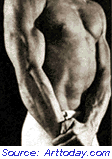Part Three in a Six-Part Series

by Alicia Potter
In pursuit of a new beauty ideal, American men are exercising themselves to death. As society demands a fitter body, frowning on every pinch of fat, clinicians suspect an increasing number of men are crossing the line into exercise addiction. Signs of obsession include feelings of acute anxiety over a missed workout and an urge to make exercise a priority over friends and family. Most trainers recommend working out no more than an hour a day.
"What we're seeing now is the same body obsession but in a new form," says Harrison G. Pope Jr., one of the researchers at McLean. "It's coming out in the '90s as a preoccupation with muscularity and size." Indeed, Pope has called muscle dysmorphia "the anorexia of the '90s." That might sound a little alarmist, but Pope says it's no exaggeration. He warns not to underestimate the power of pop culture, especially Hollywood and the flourishing men's magazine industry (Men's Health alone has increased its circulation fivefold, to 1.3 million readers, since its start in 1986). The pressure on men comes from another direction, too. Women run companies, fly fighter planes, and, yes, pump iron — leaving the boys downright anxious about the meaning of masculinity. "As androgyny and gender equality increases, it unfortunately becomes very threatening to a lot of men," says Eric Silverman, a DePauw University anthropologist who specializes in the study of body image. "Suddenly men feel like they need to redivide the genders. They need things that are exclusively masculine, even hypermasculine." For some men, that means more muscle. Indeed, the number of men exercising has increased more than 30 percent since the start of the decade. According to the research firm American Sports Data, last year nine million men belonged to a health club. And on average, they went to the gym 88 days a year. For those keeping score, that was six days more than women. Pope also adds that steroid use remains high. About one million American men have tried the drugs once; up to 6 percent have taken them by age 18. Indeed, teenage boys are on their way to becoming the next generation of body-conscious men. They avidly lift weights, blend protein shakes, and buy bodybuilding magazines. "Compare that to when I was in high school in the 1960s," says Pope. "No one even talked about working out." This article originally appeared in The Boston Phoenix. Part Four: Starved for Confidence — Male Eating Disorders |


 But men don't just worry that they are too fat; many worry that they are too thin. Researchers at McLean Hospital have just defined a body-image distortion disorder that they liken to "reverse anorexia." Called muscle dysmorphia, the syndrome appears in athletes (both male and female) who, despite being dramatically muscular, are convinced that they are too small. Imagine a bodybuilder — 250 pounds, 20-inch biceps, 6 percent body fat — horrified to take his shirt off for fear he looks out of shape.
But men don't just worry that they are too fat; many worry that they are too thin. Researchers at McLean Hospital have just defined a body-image distortion disorder that they liken to "reverse anorexia." Called muscle dysmorphia, the syndrome appears in athletes (both male and female) who, despite being dramatically muscular, are convinced that they are too small. Imagine a bodybuilder — 250 pounds, 20-inch biceps, 6 percent body fat — horrified to take his shirt off for fear he looks out of shape. 





